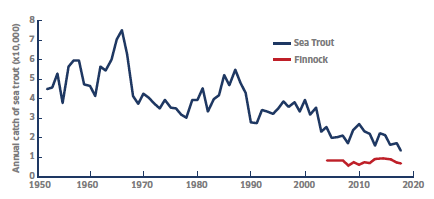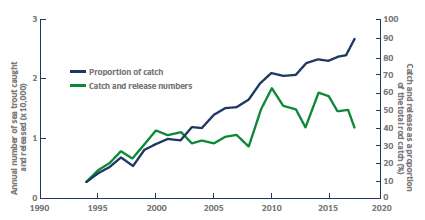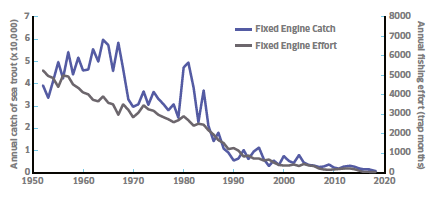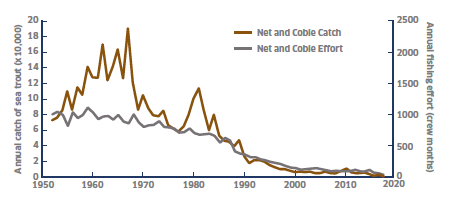Sea trout fishery statistics: 2018
This publication summarises the sea trout fishery catch statistics for the 2018 season.
Sea Trout Fishery Statistics - 2018 Season
Summary
- The total reported rod catch (retained and released) of sea trout for 2018 is 13,692. Catches have declined over much of the period since 1952, when our records began. Total reported rod catch in 2018 is the lowest on record and 69% of the previous 5 year average.
- The proportion of the total rod catch accounted for by catch and release in 2018 is 90%. This is the highest value reported since records began in 1994. A proportion of fish released from the rod fishery may be re-caught and hence inflate the catch statistics by appearing in the reported data more than once.
- Reported catch and effort for the fixed engine and net & coble fisheries were the lowest recorded since records began in 1952.
The Statistics
This publication summarises the sea trout fishery statistics based on returns from proprietors, occupiers or agents of fisheries throughout Scotland for the 2018 fishing season. These data are derived from 1,976 forms returned from 2,144 forms issued (92% return rate). Final published statistics for theprevious 10 years have been based on return rates of between 93% and 94%.
These statistics are part of a time series which began in 1952 and are collected and collated by Marine Scotland Science.
Salmon Fishery Regulations
Statutory conservation measures are in place to regulate both the killing of salmon in the early months of the fishing season (https://www2.gov.scot/Topics/marine/Salmon-Trout-Coarse/fishreform/licence/spring), in coastal waters and on stocks with poor conservation status (https://www2.gov.scot/Topics/marine/Salmon-Trout-Coarse/fishreform/licence/status).
Although specifically related to the catches of salmon, these regulations may have an impact on the catch and effort data reported by Scottish sea trout fisheries as some target both species.
Catch and Effort Reported By Scottish Sea Trout Fisheries In 2018
The rod and line fishery
In total, 1,424 sea trout were reported caught and retained in the rod and line fishery. A further 12,268 sea trout were reported caught and released. We have no comprehensive time series of fishing effort information associated with the rod and line fishery.
Total rod catches (retained and released) of sea trout for Scotland as a whole have declined over much of the period since 1952, when our records began. The total reported rod catch in 2018 of 13,692 was the lowest in the time series and 69% of the previous 5-year average (Figure 1).
Finnock are sea trout which have spent less than a year at sea and are making their first return to fresh water. They may also be known as whitling or herling. Finnock catches have been reported since 2004. The total rod catch of finnock in 2018 was 7,621, 79% of the previous 5-year average (Figure 1).
Figure 1
Rod and Line Fishery.

Catch and release
The proportion of the rod catch accounted for by catch and release has generally increased since 1994, when catch and release information was first recorded (Figure 2) and accounted for 90% of the total rod catch of sea trout in 2018. In addition 96% of finnock taken by the rod fishery were subsequently released in 2018. A proportion of fish released from the rod fishery may be re-caught and hence inflate the catch statistics by appearing in the reported data more than once.
Figure 2
Catch and Release, Rod And Line Fishery.

The net fisheries
A total of 324 sea trout was reported caught and retained in the fixed engine fishery. On the Solway, haaf net fisheries reported a total fishing effort of 212 net months. These fisheries do not yield data that can be easily combined with returns from gear types in the rest of Scotland and data from this region are generally omitted when calculating a national index for fixed engine fishing effort.
A total of 1,356 sea trout was reported caught and retained in the net & coble fishery, and the reported effort was 25.5 crew months.
Reported catch and effort in both net fisheries have declined over much of the period covered by our records and remain at low levels (Figures 3 & 4). In 2018, reported catch and effort for both the fixed engine and net & coble fisheries were the lowest recorded by either fishery since records began in 1952.
Figure 3
Fixed Engine Fishery.

Figure 4
Net and Coble Fishery.

The catch by fishing method
In 2018, 89% of the total annual reported catch was accounted for by the rod fisheries. Fixed engine and net & coble fisheries comprised 2% and 9% of the total catch respectively. Restricting the analysis to the retained catch, the rods accounted for 46% of the catch compared to 10% and 44% for the fixed engine and net & coble fisheries.
Impact of low water flows during 2018
When inferring the status of stocks from catch data, it is important to consider trends over a number of years rather than simply focusing on catch levels for the most recent year. Both numbers of sea trout caught and the allocation of catch among fishing methods may be influenced by many factors, the most obvious of which are environmental conditions.
The 2018 season catch returns provided an instructive illustration of the effects of environmental conditions on sea trout catches. In 2018 Scottish rivers experienced a prolonged period of extremely low flows throughout the year. Such low flows are known to be difficult conditions for anglers catching fish, and it is thought that sea trout delay entering rivers until flows increase,which can be towards the end of the fishing season. It is not possible to determine from catch data alone how much the drop inreported catch is a reflection of decreasing numbers returning to Scottish waters and how much is a result of challenging conditions.
Downloads
Topic sheet no. 67 explains how we collect the catch statistics.
Topic sheet no. 68 summarises the salmon fishery statistics for the 2018 fishing season.
Both topic sheets are available for download at https://www2.gov.scot/Topics/marine/Publications/TopicSheets/tslist
Summary data for fishing seasons 1952 to 2018 are available for download at https://www2.gov.scot/Topics/marine/Publications/stats/SalmonSeaTroutCatches
These data are provided as the most complete at the time of publication. Our records are amended when further information becomes available and updated annually in April when the statistics for the most recent fishing season are published.
Contact
If you have a specific request for Scottish salmon and sea trout fishery information, not available atthe links on this page, please contact us directly at ms.catchform@gov.scot
MS Salmon Assessment Group
Freshwater Laboratory Field Station
Inchbraoch House, South Quay
Ferryden, Montrose
DD10 9SL
Telephone: 0131 244 4500
Contact
Email: ms.catchform@gov.scot
There is a problem
Thanks for your feedback